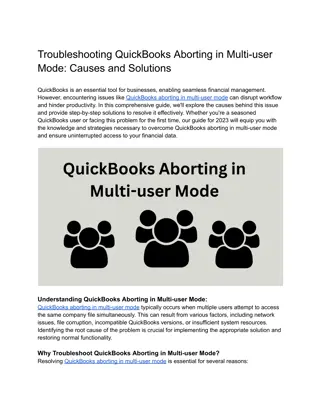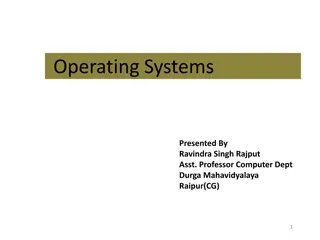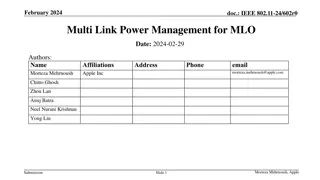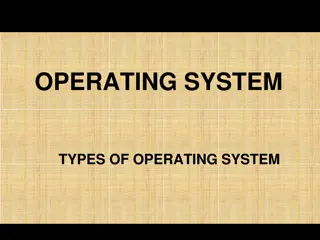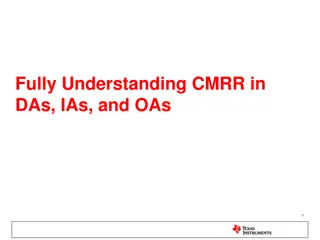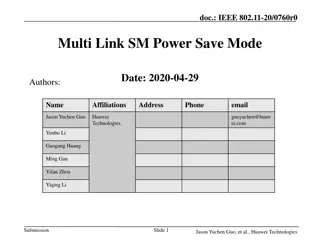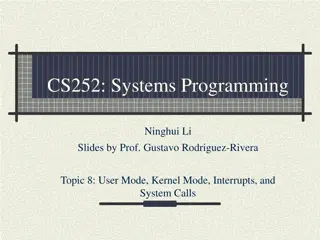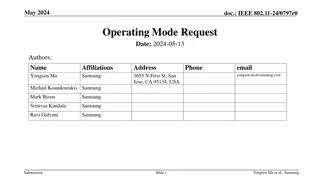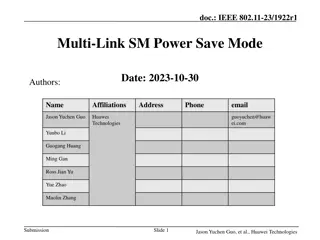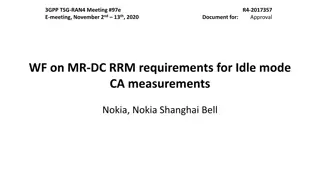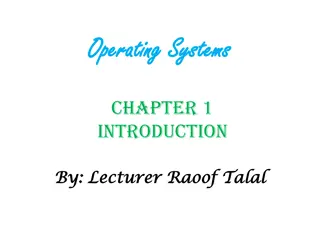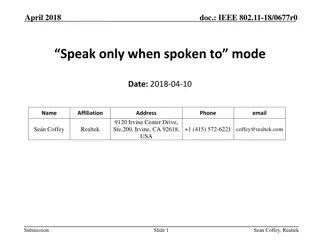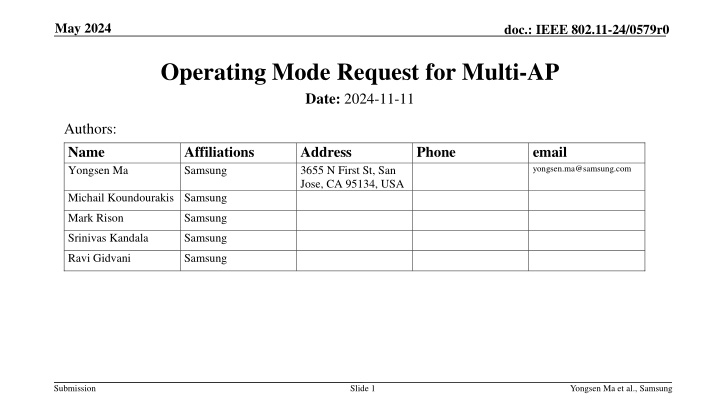
IEEE 802.11-24 Operating Mode Request for Multi-AP Use Cases
Explore the operating mode request for multi-AP scenarios in the IEEE 802.11-24 document, focusing on how a STA can notify other recipient STAs of its operating mode change. The submission delves into mechanisms for notification and indication among STAs without the negotiation of a specific operating mode. Learn how AP1 can request AP2 to adjust its operating mode parameters for improved inter-AP/BSS performance in multi-AP coordination setups.
Download Presentation

Please find below an Image/Link to download the presentation.
The content on the website is provided AS IS for your information and personal use only. It may not be sold, licensed, or shared on other websites without obtaining consent from the author. If you encounter any issues during the download, it is possible that the publisher has removed the file from their server.
You are allowed to download the files provided on this website for personal or commercial use, subject to the condition that they are used lawfully. All files are the property of their respective owners.
The content on the website is provided AS IS for your information and personal use only. It may not be sold, licensed, or shared on other websites without obtaining consent from the author.
E N D
Presentation Transcript
May 2024 doc.: IEEE 802.11-24/0579r0 Operating Mode Request for Multi-AP Date: 2024-11-11 Authors: Name Yongsen Ma Affiliations Samsung Address 3655 N First St, San Jose, CA 95134, USA Phone email yongsen.ma@samsung.com Michail Koundourakis Samsung Mark Rison Samsung Srinivas Kandala Samsung Ravi Gidvani Samsung Submission Slide 1 Yongsen Ma et al., Samsung
May 2024 doc.: IEEE 802.11-24/0579r0 Abstract A STA may change its operating mode and notify other recipient STAs of a change in its operating mode. Previous submission [1] presents Operating Mode Request to allow a STA request a second STA to run in a certain operating mode. This submission presents a follow-up of Operating Mode Request for multiple-AP use cases. Submission Slide 2 Yongsen Ma et al., Samsung
May 2024 doc.: IEEE 802.11-24/0579r0 Recap: Operating Mode Request A STA may change its operating mode (BW, NSS, etc.) and notify other STAs by different mechanisms, e.g., OMN (in management/action frame), OMI (in OM Control of A-Control) These mechanisms are used for notification/indication purposes but not for request/negotiation of a certain Operating Mode among STAs. Previous submission presents Operating Mode Request [1]: A STA may request another STA to run in a certain Operating Mode, e.g., AP to AP: multi-AP coordination (inter-BSS/ESS/vendor/admin) AP to non-AP STA Non-AP STA to AP Non-AP STA to Non-AP STA Submission Slide 3 Yongsen Ma et al., Samsung
May 2024 doc.: IEEE 802.11-24/0579r0 Operating Mode Request for Multi-AP AP1 may request AP2 to change AP2 s operating mode parameters that have impact on inter-AP/BSS performance, e.g., Existing operating mode parameters (pre-UHR) in multi-AP scenarios Primary channel location, BW, TX power, Spatial Reuse Parameter Set values New operating mode parameters (UHR and post-UHR) in multi-AP scenarios AP power save, NPCA, preemption/low latency operations Multi-AP coordination operating mode parameters (UHR and post-UHR) various multi-AP coordination schemes, such as Co-SR, Co-BF, Co-TDMA, Co-RTWT a common framework for multi-AP coordination procedures: discovery procedure and agreement negotiation procedure Submission Slide 4 Yongsen Ma et al., Samsung
May 2024 doc.: IEEE 802.11-24/0579r0 Operating Mode Request for Multi-AP: Existing Operating Mode Parameters (pre-UHR) Some operating mode parameters have impact on neighboring AP/OBSS. These operating mode parameters can be adjusted to improve inter-AP/OBSS performance, e.g., to avoid interference and improve coexistence. AP1 requests AP2 to change its primary channel location and/or BW AP1 requests AP2 to change its TX power to reduce or increase range AP1 requests AP2 to change its Spatial Reuse Parameter Set values to reduce or increase sensitivity, or to enable/disable/update spatial reuse modes Submission Slide 5 Yongsen Ma et al., Samsung
May 2024 doc.: IEEE 802.11-24/0579r0 Operating Mode Request for Multi-AP: New Operating Mode Parameters (UHR and post-UHR) For some new features being discussed in TGbn, e.g., AP power save, NPCA, and preemption: The performance of the new features is impacted by operations from nearby AP/OBSS The operations of the new features have impact on the performance of nearby AP/OBSS These features can be adjusted to improve the performance/coexistence in multi- AP scenarios AP1 requests AP2 to enable/disable AP power save or update AP power save modes/parameters AP1 requests AP2 to enable/disable NPCA or update NPCA parameters, e.g., location and/or BW of NPCA primary channel AP1 requests AP2 to enable/disable/update preemption/low latency operations Submission Slide 6 Yongsen Ma et al., Samsung
May 2024 doc.: IEEE 802.11-24/0579r0 Operating Mode Request for Multi-AP: Multi-AP Coordination Operating Mode Parameters Motions passed for TGbn to define various multi-AP coordination schemes, such as Co-SR, Co-BF, Co-TDMA, Co-RTWT, and a common framework for multi-AP coordination procedures: discovery procedure and agreement negotiation procedure [2] Operating Mode Request/Response can be used during the agreement negotiation procedure for multi-AP coordination, or after the negotiation phase when there is a need to change certain multi-AP coordination modes and the associated parameters, or during network planning/testing/troubleshooting/maintaining phases Depending on network conditions/requirements, one AP may request another AP to enable/disable certain multi-AP coordination schemes, and/or to update certain multi-AP coordination parameters. Slide 7 Submission Yongsen Ma et al., Samsung
May 2024 doc.: IEEE 802.11-24/0579r0 Operating Mode Request Element Element ID 1 Length 1 Element ID Extension (TBD) 1 Control TBD Operating Mode Request Content variable Octets: Control field Contains control information about request type, mode, ID, token, etc. Operating Mode Request Content field Contains certain existing or new information elements/fields, such as OMN element and multi-AP Operation element, or certain existing or new operating mode parameters based on the Control field Submission Slide 8 Yongsen Ma et al., Samsung
May 2024 doc.: IEEE 802.11-24/0579r0 Examples Operating Mode Notification element Spatial Reuse Parameter Set element Element ID Length Element ID Extension (TBD) Control Operating Mode Request Content Element ID Length Element ID Extension (TBD) Control Operating Mode Request Content NPCA Operation element DPS Operation element Co-SR Operation element Co-TDMA Operation element Multi-AP Element ID Length Element ID Extension (TBD) Control Operating Mode Request Content Operation element Submission Slide 9 Yongsen Ma et al., Samsung
May 2024 doc.: IEEE 802.11-24/0579r0 Discussions Operating Mode Request/Response relies on AP-to-AP communication AP-to-AP communication framework is out of scope of this submission Can reuse or be part of the AP-to-AP framework defined in the common framework for multi-AP coordination procedures Details and rules for how/when to Operating Mode Request are TBD e.g., whether Operating Mode Request can be sent from controller/controlled APs, or distributed/uncontrolled APs Submission Slide 10 Yongsen Ma et al., Samsung
May 2024 doc.: IEEE 802.11-24/0579r0 Conclusion This contribution presents Operating Mode Request for multi-AP It allows an initiating AP (e.g., controller AP) to request a responding AP (e.g., controlled AP) to change the responding AP s operating mode/parameters Pre-UHR/UHR/post-UHR operating mode/parameters Multi-AP coordination operating mode/parameters It relies on AP-to-AP communication The AP-to-AP communication is out of scope of this submission Can reuse the common framework for multi-AP coordination procedures Submission Slide 11 Yongsen Ma et al., Samsung
May 2024 doc.: IEEE 802.11-24/0579r0 References [1] 802.11-24/0797r1, Operating Mode Request, Yongsen Ma (Samsung) [2] 802.11-24/0209r5, Specification Framework for TGbn, Ross Jian Yu (Huawei) [3] IEEE P802.11REVme_D7.0, July 2024 [4] IEEE P802.11be_D7.0, July 2023 Submission Slide 12 Yongsen Ma et al., Samsung
May 2024 doc.: IEEE 802.11-24/0579r0 Straw Polls SP1: Do you support to define a mechanism in TGbn to allow an AP request a second AP to change the second AP s operating mode and associated parameters? Note 1: The operating modes that can be requested to be changed are TBD, e.g., spatial reuse parameters, NPCA parameters, and multi-AP coordination parameters. Note 2: The request can be in an action frame or Operating Mode Request element: details are TBD. Note 3: AP-to-AP communication is needed to support request/response between APs: details are TBD. Result: Y: , N: , A: Submission Slide 13 Yongsen Ma et al., Samsung

